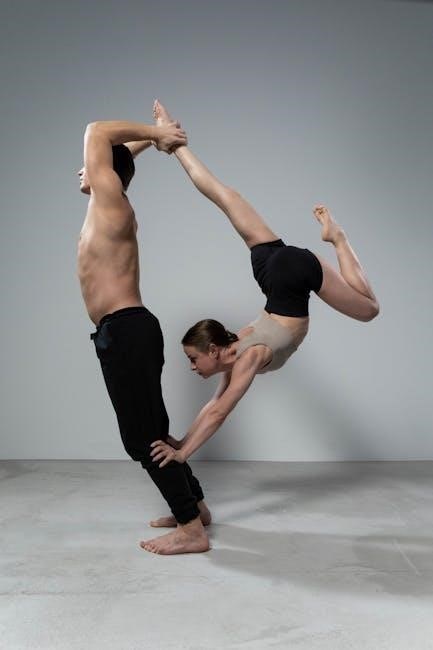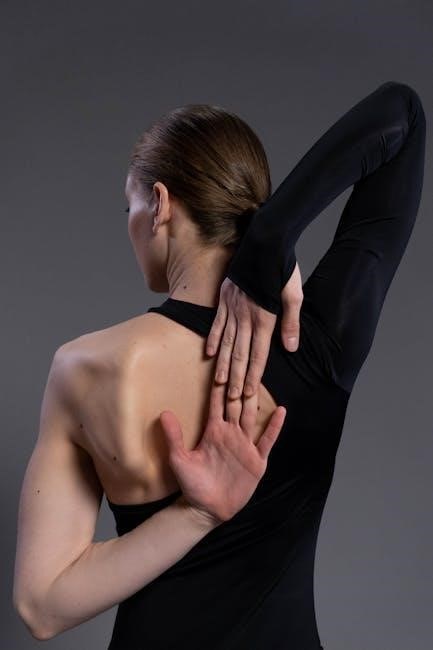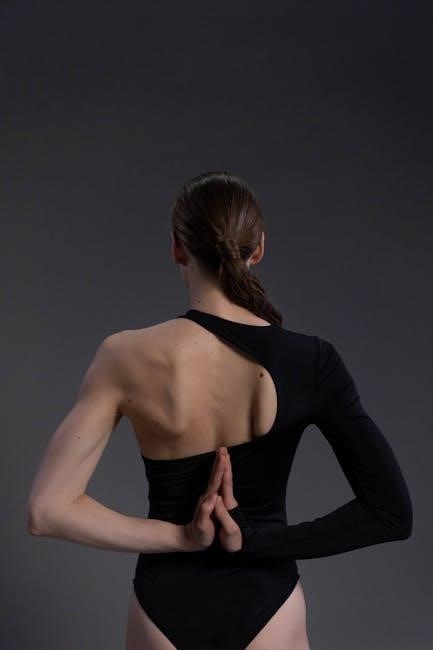A comprehensive guide to Hatha Yoga, this PDF offers structured sequences promoting relaxation, flexibility, and strength. Ideal for all levels, it provides step-by-step instructions and visual aids.
1.1 Overview of Hatha Yoga
Hatha Yoga is a traditional practice focusing on physical postures (asanas) and breathing techniques (pranayama) to balance the body’s energy. Originating as a holistic approach, it aims to prepare the body for meditation and spiritual growth. Unlike dynamic styles, Hatha Yoga emphasizes holding poses for extended periods, promoting flexibility, strength, and relaxation. Suitable for all levels, it serves as a foundation for many modern yoga styles, offering a serene and meditative experience for both beginners and advanced practitioners.
1.2 Importance of a Structured Sequence
A structured Hatha Yoga sequence ensures a safe and progressive practice, allowing practitioners to build strength, flexibility, and mindfulness. It guides the flow of energy, preventing injuries and enhancing the effectiveness of each pose. A well-designed sequence caters to all levels, providing modifications and clear transitions; This organized approach helps maintain focus, fostering a meditative state and promoting overall well-being. A structured sequence in a PDF format makes it easy to follow, enabling a consistent and transformative home practice.
1.3 Benefits of Using a PDF Guide
A Hatha Yoga sequence PDF offers convenience, portability, and clarity. It provides detailed instructions, visuals, and step-by-step cues, making it accessible for all levels. The PDF format ensures consistent practice, allowing users to follow sequences anytime, anywhere without internet. Printable and shareable, it serves as a valuable resource for home practice, teaching, or class planning. Clear illustrations and modifications enhance understanding, helping practitioners achieve proper alignment and maximize benefits. A PDF guide is an essential tool for deepening your Hatha Yoga journey.
Understanding the Structure of a Hatha Yoga Sequence
A well-structured Hatha Yoga sequence typically includes warm-up, standing postures, seated poses, reclined postures, and relaxation. It balances physical postures, breathing techniques, and mindfulness for holistic practice.
2.1 Warm-Up and Preparation
A proper warm-up is essential to prepare the body and mind for Hatha Yoga. Begin with 5-10 minutes of gentle stretches, sun salutations, or seated breathing exercises to increase circulation and flexibility. Set an intention for your practice, focusing on mindfulness and breath awareness. Incorporate cat-cow stretches, neck rolls, and wrist or ankle rotations to loosen joints. Use props like blocks or straps if needed to ensure comfort and alignment, creating a smooth transition into the main sequence.
2.2 Main Sequence: Standing Postures
Standing postures form the foundation of a Hatha Yoga sequence, building strength and balance. Begin with Mountain Pose (Tadasana) to establish alignment, followed by Warrior I and II for leg strength and hip opening. Transition into Triangle Pose (Trikonasana) and Extended Side Angle Pose to stretch the spine and shoulders. Incorporate Tree Pose (Vrksasana) for balance and Eagle Pose (Garudasana) to engage the legs and hips, ensuring each pose is held with steady breath and awareness, fostering stability and focus throughout the practice.
2.3 Main Sequence: Seated Postures
Transition to seated postures to deepen flexibility and release tension. Begin with Easy Pose (Sukhasana) or Staff Pose (Dandasana) for alignment. Move into Seated Forward Bend (Paschimottanasana) to stretch the hamstrings and spine. Incorporate Seated Spinal Twist (Bharadvajasana) to enhance spinal mobility and detoxify.Finish with Seated Leg Stretch (Akarna Dhanurasana) for hip opening and balance. These postures promote relaxation, improve circulation, and prepare the body for deeper relaxation or meditation, fostering a sense of calm and inner harmony.
2.4 Main Sequence: Reclined Postures
Reclined postures provide deep relaxation and rejuvenation. Begin with Reclined Pigeon Pose (Supta Eka Pada Rajakapotasana) to release hip tension. Move into Reclined Spinal Twist (Supta Matsyendrasana) to unwind the spine and improve digestion. Follow with Legs-Up-The-Wall Pose (Viparita Karani) to calm the nervous system and reduce swelling in the legs. Conclude with Reclined Goddess Pose (Supta Baddha Konasana) to open the chest and promote heart-centered energy. These postures foster rest, renewal, and mental clarity, preparing the body for a restorative conclusion to the sequence.
2.5 Cool Down and Relaxation
The cool-down phase focuses on relaxation and restoring balance; Begin with Savasana (Corpse Pose) to quiet the mind and release tension. Incorporate gentle twists, such as Reclined Spinal Twist, to soothe the lower back. Follow with Reclined Pigeon Pose to release hip tension. Conclude with guided breathing exercises, like Alternate Nostril Breathing, to calm the nervous system. This segment prepares the body for a restful state, ensuring a peaceful transition to the end of your practice, leaving you refreshed and centered.

Creating Your Own Hatha Yoga Sequence PDF
Design a customizable Hatha Yoga practice with structured sequences, visual guides, and alignment cues. Include modifications and timing to create a balanced, safe, and effective routine for all levels.
3.1 Elements of a Printable Sequence
A well-structured Hatha Yoga PDF should include warm-up routines, main postures, and cool-down stretches. Add visual guides for poses, alignment cues, and modifications. Timing and breathing techniques enhance the practice. Include clear instructions for each pose, focusing on safety and effectiveness. Use high-quality images or illustrations to demonstrate postures. Ensure the sequence flows logically, balancing standing, seated, and reclined poses. Provide options for different levels, making it accessible to beginners and experienced practitioners alike. This creates a comprehensive and user-friendly guide for home or studio practice.
3.2 Visual Guides and Illustrations
Enhance your Hatha Yoga PDF with detailed visual guides, including pose illustrations and step-by-step instructions. High-quality images or diagrams help users understand proper alignment and modifications. Use stick figures or photographs to demonstrate each posture clearly. Illustrations of sequences, such as sun salutations or warrior flows, provide a visual flow for smooth transitions. Ensure visuals are clear and concise, complementing written instructions. This makes the guide accessible and easy to follow, even for those new to Hatha Yoga.
3.3 Alignment Cues and Modifications
Incorporate alignment cues to ensure safe and effective practice. Provide modifications for each pose, catering to different levels and abilities. Include tips on breathing techniques and engagement of core muscles. Offer alternatives for challenging postures, such as using props like blocks or straps. Clear instructions guide users to adapt poses to their needs, fostering a safe and inclusive practice environment. This ensures the sequence is accessible for everyone, from beginners to advanced practitioners, promoting balance and well-being.
3.4 Timing and Duration Guidelines
Include detailed timing for each pose and sequence to ensure a balanced practice. Provide guidelines for class duration, from 10 to 90 minutes, adapting to different levels. Offer tips on pacing, such as holding postures for 3-5 breaths and transitioning smoothly. Specify warm-up, main sequence, and cool-down durations. This helps users customize their practice, ensuring efficiency and alignment with their goals. Clear timing enhances focus and progression, making the sequence adaptable for various schedules and objectives.

Popular Hatha Yoga Sequences for Beginners
Discover gentle and effective Hatha Yoga sequences tailored for beginners, offering structured practices from 10 to 90 minutes. These sequences promote flexibility, strength, and relaxation, perfect for all levels.
4.1 10-Minute Hatha Yoga Sequence
A quick and effective 10-minute sequence perfect for busy days. Start with Mountain Pose for grounding, then flow into Child’s Pose for a gentle stretch. Transition into Cat-Cow to warm up the spine, followed by Downward Dog for strength. End with Seated Forward Fold to release tension and Savasana for relaxation. This sequence improves flexibility, calms the mind, and sets a positive tone for the day. Ideal for beginners seeking a short yet impactful practice.
4.2 20-Minute Hatha Yoga Sequence
Begin with Sun Salutations to warm up, then transition into Warrior I and II for strength and balance. Follow with Triangle Pose and Seated Forward Fold to stretch the hamstrings and spine. Include Plank and Low Push-Up for core engagement, then move into Child’s Pose for relaxation. End with Savasana and a short seated meditation to calm the mind. This sequence balances physical postures with relaxation, perfect for a mid-day refresh or evening unwind. It promotes flexibility, strength, and mental clarity in just 20 minutes.
4.3 45-Minute Hatha Yoga Sequence
Start with a 5-minute warm-up, including neck rolls and shoulder stretches. Move into standing postures like Mountain, Warrior I, and Triangle for strength and balance. Transition to seated stretches, such as Seated Forward Fold and Spinal Twist, to deepen flexibility. Incorporate core-strengthening poses like Boat and Plank; Conclude with reclined postures, like Legs-Up-The-Wall and Savasana, for relaxation. This sequence provides a balanced practice, combining physical postures, breath awareness, and relaxation to rejuvenate the body and mind in 45 minutes.
4.4 60-Minute Hatha Yoga Sequence
Begin with a 10-minute warm-up, including sun salutations and breathing exercises. Transition into standing postures like Warrior I, Warrior II, and Triangle Pose for strength and balance. Move to seated postures such as Seated Forward Fold, Seated Twist, and Cobbler’s Pose for flexibility. Incorporate reclined postures like Legs-Up-The-Wall and Reclined Pigeon for relaxation. Conclude with a 5-10 minute Savasana for deep relaxation. This sequence balances physical postures, breath awareness, and relaxation, offering a comprehensive practice for body and mind.
4.5 90-Minute Hatha Yoga Sequence
A 90-minute Hatha Yoga sequence offers an extended practice, allowing for deeper exploration of postures and relaxation. Begin with a 15-minute warm-up, including sun salutations and pranayama. Progress through standing postures like Warrior I, II, and III, followed by seated poses such as Seated Forward Fold and Seated Twist. Incorporate reclined postures like Reclined Pigeon and Legs-Up-The-Wall for release. Conclude with a 10-minute Savasana and a final relaxation. This sequence provides a holistic practice, enhancing flexibility, strength, and mental calm, perfect for those seeking a more immersive experience.

Advanced Hatha Yoga Sequences
Advanced sequences incorporate intermediate standing, seated, and reclined postures, along with twists, backbends, and balancing poses. These challenge experienced practitioners, enhancing strength, flexibility, and mental focus.
5.1 Intermediate Standing Postures
Intermediate standing postures in Hatha Yoga build on foundational moves, introducing complexity and depth. Practices include Warrior I and II, Triangle Pose, and Revolved Triangle, enhancing balance, strength, and focus. These postures challenge stability, improve alignment, and prepare the body for more advanced sequences. Modifications are often suggested to accommodate different levels, ensuring safety and accessibility. Props like blocks or walls can assist in maintaining proper form; Regular practice of these postures fosters resilience and mental clarity, deepening the overall yoga experience.
5.2 Intermediate Seated Postures
Intermediate seated postures in Hatha Yoga refine flexibility and strength, offering deeper stretches and improved alignment. Practices include Seated Forward Bend, Cobra Pose, and Seated Spinal Twist, which enhance spinal health and inner calm. These postures require attention to breath and form, building on foundational seated asanas. Modifications and props are often recommended to ensure accessibility and proper alignment. Regular practice strengthens the core, improves posture, and prepares the body for advanced seated sequences, fostering balance and mental focus.
5.3 Intermediate Reclined Postures
Intermediate reclined postures in Hatha Yoga are designed to deepen relaxation, improve spinal flexibility, and enhance breath awareness. Practices like Reclined Spinal Twist and Legs-Up-The-Wall Pose target the lower back and hips, promoting release and rejuvenation. These postures often incorporate props for support, ensuring proper alignment and comfort. They prepare the body for more advanced reclined asanas while fostering a calm, meditative state. Regular practice improves circulation, reduces tension, and strengthens the connection between body and breath, advancing overall well-being.
5.4 Intermediate Twists and Backbends
Intermediate twists and backbends in Hatha Yoga build on foundational poses, enhancing flexibility and energy flow. Practices like Seated Spinal Twist (Bharadvajasana) and Bridge Pose (Setu Bandha Sarvangasana) strengthen the spine and open the chest. These poses improve posture, balance, and breath capacity; Modifications and props are often used to ensure safety and alignment. Regular practice prepares the body for more advanced sequences, fostering strength, mobility, and mental focus. They are integral to a balanced practice, promoting physical and energetic harmony.
5.5 Intermediate Balancing and Restorative Postures
Intermediate balancing postures, such as Tree Pose (Vrksasana) and Eagle Pose (Garudasana), refine equilibrium and mental focus. Restorative postures like Legs-Up-The-Wall (Viparita Karani) and Supported Forward Fold (Prasarita Padottanasana) promote deep relaxation. These practices enhance physical stability, reduce stress, and rejuvenate the body. Props like blocks and blankets are often used to ensure comfort and proper alignment. Regular practice strengthens core stability, improves circulation, and prepares the body for deeper relaxation and meditation, fostering overall well-being.
Customizing Your Hatha Yoga Practice
Tailor your Hatha Yoga practice to meet personal goals, incorporating modifications and props to enhance flexibility, strength, and relaxation. Perfect for all levels.
6.1 Sequencing for Flexibility
Design a Hatha Yoga sequence focused on enhancing flexibility by incorporating gentle warm-ups, sun salutations, and seated postures. Begin with breathing exercises to prepare the body. Include forward bends like Uttanasana and seated stretches such as Baddha Konasana. Gentle twists and spinal movements, like Bhujangasana, can improve range of motion. Conclude with restorative postures and final relaxation to maximize flexibility gains. Use props for support and modify poses to suit individual needs for a safe, effective practice.
6.2 Sequencing for Strength
A Hatha Yoga sequence for strength focuses on building endurance and muscular stability. Begin with dynamic warm-ups like sun salutations to activate the body. Incorporate standing postures such as Warrior I (Virabhadrasana I) and Warrior II (Virabhadrasana II) to engage the legs and core. Add balancing poses like Tree Pose (Vrksasana) to improve stability. Include strength-building postures like Plank Pose (Phalakasana) and Boat Pose (Paripurna Navasana). Conclude with cooling stretches to promote recovery. Use alignment cues and modifications to ensure poses are accessible and effective for all levels.
6.3 Sequencing for Relaxation
A Hatha Yoga sequence for relaxation emphasizes calming postures and breathing techniques. Begin with gentle warm-ups like neck rolls and shoulder stretches. Incorporate seated postures such as Seated Forward Bend (Paschimottanasana) and Reclined Spinal Twist (Supta Matsyendrasana) to promote deep relaxation. Use props like blankets or bolsters for comfort. Conclude with legs-up-the-wall pose (Viparita Karani) and Savasana for a meditative finish. This sequence helps calm the mind, reduce stress, and restore energy, making it ideal for unwinding after a busy day.
6.4 Sequencing for Balance and Coordination
A Hatha Yoga sequence for balance and coordination focuses on postures that enhance stability and body awareness. Begin with standing poses like Warrior II (Virabhadrasana II) and Tree Pose (Vrksasana) to build foundational balance. Include seated postures such as Seated Forward Bend (Paschimottanasana) and Reclined Spinal Twist (Supta Matsyendrasana) to improve alignment and focus. Add gentle twists and balancing postures like Half Moon Pose (Ardha Chandrasana) to challenge coordination. Use props like blocks or a wall for support. Conclude with restorative postures to relax and integrate the benefits. This sequence improves overall equilibrium and mental clarity.
Safety and Modifications
Ensure a safe Hatha Yoga practice by modifying poses, using props, and avoiding common injuries. Proper alignment and breathing techniques enhance safety and effectiveness.
7.1 Modifying Poses for Different Levels
Modifying Hatha Yoga poses ensures accessibility for all practitioners, regardless of skill or mobility. Beginner-friendly adjustments include using blocks, straps, or reducing pose depth. Intermediate and advanced levels can incorporate deeper stretches or holds. props like bolsters and blankets provide support, making postures safer and more comfortable. This approach allows students to honor their bodies while progressing in their practice effectively.
7.2 Avoiding Common Injuries
Preventing injuries in Hatha Yoga requires attention to proper alignment, breath awareness, and honoring physical limitations. Overstretching, improper weight distribution, and forceful movements are common risks. Practitioners should listen to their bodies, avoid pushing past pain, and use modifications as needed. Warm-ups and gradual progression help prepare the body for deeper postures. Instructors should emphasize safe practices and provide alternatives to ensure a secure and beneficial experience for all students.
7.3 Using Props and Aids
Props such as blocks, blankets, straps, and bolsters are essential for modifying poses and ensuring accessibility. They help maintain proper alignment, reduce strain, and enhance comfort. Blocks support hands in standing poses, while blankets provide cushioning for joints. Straps assist in deepening stretches safely, and bolsters aid in relaxation postures. Incorporating props allows practitioners of all levels to benefit from Hatha Yoga without risking injury, making the practice inclusive and effective for everyone.
Resources and Further Reading
Explore recommended PDF guides, online forums, and books for in-depth Hatha Yoga sequences. These resources offer comprehensive poses, tips, and inspiration to enhance your practice.
8.1 Recommended PDF Guides
Discover curated Hatha Yoga PDF guides offering structured sequences for all levels. From 10-minute routines to advanced practices, these resources provide detailed poses, breathing techniques, and modifications. Popular guides include the 10-Minute Hatha Yoga Sequence and 45-Minute Gentle Hatha Flow, available on platforms like PureFlow.Yoga. Additionally, downloadable lesson plans and pose illustrations are perfect for teachers and home practitioners, ensuring a comprehensive and accessible practice experience.
8.2 Online Communities and Forums
Engage with online communities like PureFlow.Yoga and Tummee.com for Hatha Yoga resources. These forums offer discussions, shared sequences, and downloadable PDF guides. Connect with yogis worldwide, ask questions, and gain insights from experienced practitioners. Many platforms provide free downloadable content, including pose illustrations and class plans. Joining these groups fosters a supportive environment for learning and refining your Hatha Yoga practice, ensuring access to diverse and adaptable sequences tailored to your needs.
8.3 Books and Manuals
Explore detailed Hatha Yoga books and manuals for in-depth practice guidance. Titles like Hatha-Yoga Practice. Modern Styles by Maria Nikolaeva offer comprehensive insights, available in formats like PDF, fb2, and epub. Classical texts such as the Hatha Yoga Pradipika provide foundational knowledge, while modern manuals include pose illustrations and sequencing tips. These resources are perfect for both beginners and advanced practitioners, offering structured approaches to mastering Hatha Yoga techniques and sequences.
Embrace Hatha Yoga’s timeless benefits with structured sequences. Whether for relaxation, flexibility, or strength, consistent practice fosters harmony in body and mind. Start your journey today.
9.1 Final Thoughts on Hatha Yoga Sequences
Hatha Yoga sequences offer a transformative pathway to physical, mental, and emotional well-being. Structured PDF guides provide clarity, ensuring practices are accessible and effective for all levels. From warm-ups to relaxation, these sequences balance strength, flexibility, and mindfulness. Visual aids and modifications enhance understanding, making them ideal for home or classroom use. Embrace consistency and patience, allowing the ancient wisdom of Hatha Yoga to guide your journey toward holistic health and inner peace.
9.2 Encouragement to Start Your Practice
Embarking on a Hatha Yoga journey is a profound step toward self-discovery and wellness. With a PDF guide, you can create a personalized practice tailored to your goals and pace. Whether seeking relaxation, strength, or flexibility, Hatha Yoga offers timeless benefits. Start small, stay consistent, and embrace the transformative power of this ancient practice. Download your PDF today and begin your path to serenity, balance, and a deeper connection with your body and mind.



